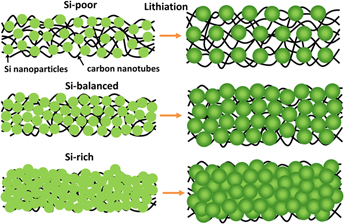Crossref Citations
This article has been cited by the following publications. This list is generated based on data provided by
Crossref.
Ren, Wen‐Feng
Li, Jun‐Tao
Huang, Zhi‐Gen
Deng, Li
Zhou, Yao
Huang, Ling
and
Sun, Shi‐Gang
2018.
Fabrication of Si Nanoparticles@Conductive Carbon Framework@Polymer Composite as High‐Areal‐Capacity Anode of Lithium‐Ion Batteries.
ChemElectroChem,
Vol. 5,
Issue. 21,
p.
3258.
Tai, Xia
Li, Xifei
Kakimov, Alibek
Li, Shiyu
Liu, Wen
Li, Jianwei
Xu, Jie
Li, Dejun
and
Sun, Xueliang
2019.
Optimized ALD-derived MgO coating layers enhancing silicon anode performance for lithium ion batteries.
Journal of Materials Research,
Vol. 34,
Issue. 14,
p.
2425.
Hasegawa, George
Kanamori, Kazuyoshi
Nakanishi, Kazuki
and
Hayashi, Katsuro
2019.
Thermogravimetric Evolved Gas Analysis and Microscopic Elemental Mapping of the Solid Electrolyte Interphase on Silicon Incorporated in Free-Standing Porous Carbon Electrodes.
Langmuir,
Vol. 35,
Issue. 39,
p.
12680.
Xu, Yaolin
Borsa, Dana M.
and
Mulder, Fokko M.
2019.
Engineering the Direct Deposition of Si Nanoparticles for Improved Performance in Li-Ion Batteries.
Journal of The Electrochemical Society,
Vol. 166,
Issue. 3,
p.
A5252.
Yang, Yang
Yuan, Wei
Kang, Wenquan
Ye, Yintong
Yuan, Yuhang
Qiu, Zhiqiang
Wang, Chun
Zhang, Xiaoqing
Ke, Yuzhi
and
Tang, Yong
2020.
Silicon-nanoparticle-based composites for advanced lithium-ion battery anodes.
Nanoscale,
Vol. 12,
Issue. 14,
p.
7461.
Yang, Guang
Tao, Runming
Jafta, Charl J.
Shen, Chao
Zhao, Sheng
He, Lilin
Belharouak, Ilias
and
Nanda, Jagjit
2021.
Investigating Multiscale Spatial Distribution of Sulfur in a CNT Scaffold and Its Impact on Li–S Cell Performance.
The Journal of Physical Chemistry C,
Vol. 125,
Issue. 24,
p.
13146.
He, Xinyi
Yue, Fan
Shang, Zhenzhen
Wang, Jian
Gu, Wenhua
and
Huang, Xiaodong
2021.
Freestanding symmetrical SiN/Si/SiN composite coated on carbon nanotube paper for a high-performance lithium-ion battery anode based on synergistic effects.
RSC Advances,
Vol. 11,
Issue. 45,
p.
28107.
Britton, James
Krukiewicz, Katarzyna
Chandran, Malu
Fernandez, Jorge
Poudel, Anup
Sarasua, Jose-Ramon
FitzGerald, Una
and
Biggs, Manus J.P.
2021.
A flexible strain-responsive sensor fabricated from a biocompatible electronic ink via an additive-manufacturing process.
Materials & Design,
Vol. 206,
Issue. ,
p.
109700.
Islam, Jahidul
Chowdhury, Faisal I.
Uddin, Join
Amin, Rifat
and
Uddin, Jamal
2021.
Review on carbonaceous materials and metal composites in deformable electrodes for flexible lithium-ion batteries.
RSC Advances,
Vol. 11,
Issue. 11,
p.
5958.
Nyamaa, Oyunbayar
Bae, Joo-Hyeon
Seo, Duck-hyeon
Jeong, Hyo-Min
Huh, Sun-Chul
Yang, Jeong-Hyeon
Dolgor, Erdenechimeg
and
Noh, Jung-Pil
2021.
Electrochemical performance of Si thin-film with buckypaper for flexible lithium-ion batteries.
Diamond and Related Materials,
Vol. 115,
Issue. ,
p.
108351.
Yaroslavtsev, Andrey B
and
Stenina, Irina A
2021.
Carbon coating of electrode materials for lithium-ion batteries.
Surface Innovations,
Vol. 9,
Issue. 2-3,
p.
92.
Krukiewicz, Katarzyna
Britton, James
Więcławska, Daria
Skorupa, Małgorzata
Fernandez, Jorge
Sarasua, Jose-Ramon
and
Biggs, Manus J. P.
2021.
Electrical percolation in extrinsically conducting, poly(ε-decalactone) composite neural interface materials.
Scientific Reports,
Vol. 11,
Issue. 1,
Wen, Shaohui
Lu, Bo
Zhao, Yanfei
Song, Yicheng
and
Zhang, Junqian
2021.
Feigned death induced by partial delithiation in silicon composite electrodes.
Journal of Power Sources,
Vol. 495,
Issue. ,
p.
229763.
Nyamaa, Oyunbayar
Seo, Duck-Hyeon
Lee, Jun-Seok
Jeong, Hyo-Min
Huh, Sun-Chul
Yang, Jeong-Hyeon
Dolgor, Erdenechimeg
and
Noh, Jung-Pil
2021.
High Electrochemical Performance Silicon Thin-Film Free-Standing Electrodes Based on Buckypaper for Flexible Lithium-Ion Batteries.
Materials,
Vol. 14,
Issue. 8,
p.
2053.
Kuznetsov, Oleg A.
Mohanty, Shaswat
Pigos, Elena
Chen, Gugang
Cai, Wei
and
Harutyunyan, Avetik R.
2023.
High energy density flexible and ecofriendly lithium-ion smart battery.
Energy Storage Materials,
Vol. 54,
Issue. ,
p.
266.
Cho, Youngseul
Lee, Eunji
Lee, Kyu Sang
Hwang, Seon Jae
Kim, Chae Won
Kim, Taek-Gyoung
Kang, Seong-Kyun
Park, Sang Yoon
Yoo, Kwanghyun
and
Piao, Yuanzhe
2023.
CNT ink as an electrode additive for an effective hybrid conductive network in silicon microparticle/graphite anodes.
Electrochimica Acta,
Vol. 447,
Issue. ,
p.
142134.
Khan, Mustafa
Yan, Suxia
Ali, Mujahid
Mahmood, Faisal
Zheng, Yang
Li, Guochun
Liu, Junfeng
Song, Xiaohui
and
Wang, Yong
2024.
Innovative Solutions for High-Performance Silicon Anodes in Lithium-Ion Batteries: Overcoming Challenges and Real-World Applications.
Nano-Micro Letters,
Vol. 16,
Issue. 1,
Bogdanova, Alisa R.
Obrezkov, Filipp A.
Khabushev, Eldar M.
Kong, Xiangze
and
Kallio, Tanja
2024.
Binder-free LiNi0.8Mn0.1Co0.1O2 electrode enabled by single-walled carbon nanotube coating for Li-ion batteries.
Journal of Energy Storage,
Vol. 104,
Issue. ,
p.
114627.
Jeon, Eunseo
Kim, Haneum
Song, Yeeun
and
Lee, Doojin
2025.
Rheological modeling and optimization of Si-SWCNT anode slurry coatings for enhanced capacity and stability in lithium-ion batteries.
Carbon,
Vol. 236,
Issue. ,
p.
120080.
Jin, Joo Hwan
Lee, Do Geun
Kim, Jung Hoon
Hong, Sumin
Lim, Seola
Cho, Joon Young
Yoon, Jihee
Kim, Jeongmo
Park, Jong Hwan
and
Han, Joong Tark
2025.
Graphene‐Assisted Interfacial Engineering to Develop Binder‐ and Dispersant‐Free Cast Si Alloy/Nanocarbon Anodes for High‐Performance Li‐Ion Batteries.
Advanced Functional Materials,



